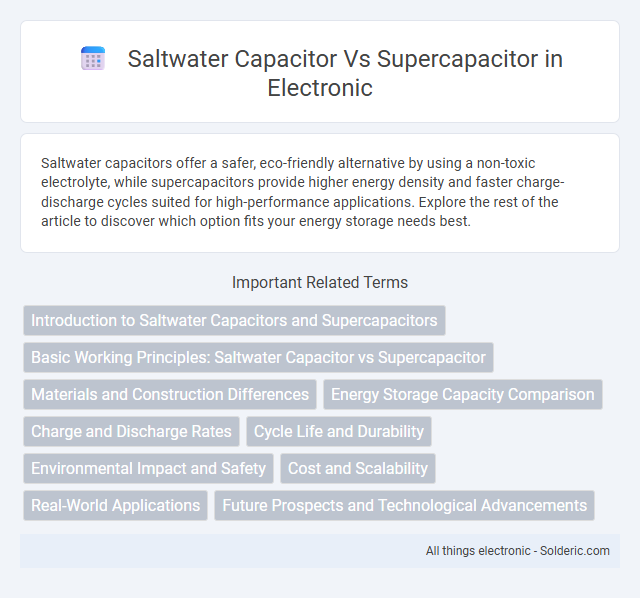Saltwater capacitors offer a safer, eco-friendly alternative by using a non-toxic electrolyte, while supercapacitors provide higher energy density and faster charge-discharge cycles suited for high-performance applications. Explore the rest of the article to discover which option fits your energy storage needs best.
Comparison Table
| Feature | Saltwater Capacitor | Supercapacitor |
|---|---|---|
| Electrolyte Type | Saltwater (aqueous electrolyte) | Organic or aqueous electrolyte |
| Energy Density | Low (~1-5 Wh/kg) | Medium to High (~5-10 Wh/kg) |
| Power Density | High (rapid charge/discharge) | Very High (instant energy delivery) |
| Operating Voltage | Low (typically < 1.5 V) | Higher (up to 2.7 V per cell) |
| Cycle Life | Long (100,000+ cycles) | Very Long (up to 1 million cycles) |
| Cost | Low (non-toxic, cheap materials) | Medium to High (carbon materials, specialized electrolytes) |
| Environmental Impact | Eco-friendly, non-toxic | Moderate (depends on materials used) |
| Application | Low-power, safe energy storage | High power, energy buffering, regenerative braking |
Introduction to Saltwater Capacitors and Supercapacitors
Saltwater capacitors utilize a saline solution as the electrolyte, offering an eco-friendly and low-cost alternative to traditional supercapacitors that typically use activated carbon electrodes and organic electrolytes. Supercapacitors provide high power density and rapid charge-discharge cycles, making them ideal for energy storage in electric vehicles and renewable energy systems. Saltwater capacitors deliver moderate energy density with enhanced safety and biodegradability, positioning them as a sustainable option for low-power applications.
Basic Working Principles: Saltwater Capacitor vs Supercapacitor
Saltwater capacitors store energy using an electrolyte composed of saltwater, where ionic movement within the saline solution generates capacitance through electrochemical double-layer formation. In contrast, supercapacitors utilize activated carbon electrodes with a high surface area to facilitate charge separation at the electrode-electrolyte interface, enabling rapid charge and discharge cycles. Both devices rely on electrostatic charge storage but differ in materials and electrolyte composition affecting energy density and environmental impact.
Materials and Construction Differences
Saltwater capacitors utilize environmentally friendly, non-toxic aqueous electrolytes combined with activated carbon electrodes, resulting in safer, biodegradable components. Supercapacitors feature organic electrolytes or ionic liquids paired with porous carbon or metal oxide electrodes, enabling higher voltage tolerance and energy density. The distinct electrolyte compositions and electrode materials in these capacitors directly influence performance characteristics, such as power density, cycle life, and operating voltage range.
Energy Storage Capacity Comparison
Saltwater capacitors generally offer lower energy storage capacity compared to supercapacitors due to their use of non-toxic, aqueous electrolytes that limit voltage and charge density. Supercapacitors utilize advanced materials like activated carbon or graphene, enabling significantly higher capacitance and energy density for applications requiring rapid charge and discharge cycles. Your choice depends on balancing safety and environmental benefits of saltwater capacitors against the superior performance and storage capacity of supercapacitors.
Charge and Discharge Rates
Saltwater capacitors exhibit moderate charge and discharge rates suitable for applications requiring safe, eco-friendly energy storage with lower power density. Supercapacitors deliver significantly faster charge and discharge rates, enabling rapid energy transfer and high power output crucial for power backup and regenerative braking systems. Your choice depends on whether quick responsiveness or environmental considerations are more important in your energy storage solution.
Cycle Life and Durability
Saltwater capacitors offer impressive cycle life and durability due to their non-toxic, aqueous electrolyte, which reduces corrosion and extends operational lifespan compared to traditional supercapacitors. Supercapacitors typically provide high power density and fast charge-discharge cycles but may experience degradation faster due to organic electrolytes and electrode wear. Your choice between saltwater capacitors and supercapacitors should consider longevity needs, as saltwater variants often deliver longer cycle life with safer, more environmentally friendly materials.
Environmental Impact and Safety
Saltwater capacitors use non-toxic, biodegradable electrolytes derived from natural salts, significantly reducing environmental hazards and disposal concerns compared to supercapacitors that often rely on hazardous organic solvents or heavy metals. Their aqueous electrolyte composition minimizes fire risks and chemical leakage, enhancing overall operational safety. In contrast, supercapacitors, while offering higher energy densities, pose greater environmental and safety challenges due to their toxic electrolyte components and potential for thermal runaway.
Cost and Scalability
Saltwater capacitors offer a cost-effective alternative to traditional supercapacitors due to their use of abundant, non-toxic materials, significantly lowering production expenses. Scalability is an advantage for saltwater capacitors, as they can be easily manufactured in larger sizes without complex fabrication processes, making them suitable for various applications requiring energy storage. Your choice between these capacitors should consider the balance between initial investment and long-term scalability depending on the specific energy storage needs.
Real-World Applications
Saltwater capacitors excel in eco-friendly energy storage solutions for low-power applications such as wearable devices and small sensors due to their non-toxic and biodegradable electrolyte. Supercapacitors dominate in high-performance fields requiring rapid charge-discharge cycles and high power density, including electric vehicles, grid energy storage, and industrial power backup systems. Both technologies contribute to sustainable energy management but target distinct real-world use cases based on their electrochemical properties and scalability.
Future Prospects and Technological Advancements
Saltwater capacitors offer eco-friendly, non-toxic energy storage with potential for safer large-scale applications, while supercapacitors excel in high power density and rapid charge-discharge cycles. Emerging technologies aim to enhance saltwater capacitor conductivity and energy density, bridging the gap with supercapacitors' performance for sustainable power solutions. Your choice between these depends on prioritizing environmental impact or maximum energy efficiency in future energy storage systems.
Saltwater capacitor vs supercapacitor Infographic

 solderic.com
solderic.com